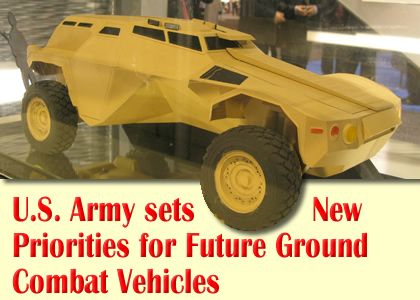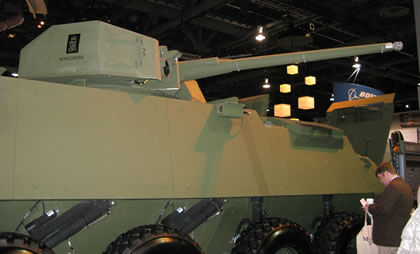AUSA, Washington DC, October 2009: Awaiting the imminent release of the U.S. Army’s largest acquisition of tactical armored vehicles in years, the next generation Ground Combat Vehicle (GCV) was the hottest item on the AUSA 2009 exhibition, but neither the Army, nor industry has even a clue about how these vehicles will look like or if they will be tracked, wheeled or both.
The Army’s U.S. Army’s TACOM Life Cycle Management Command (LCMC) is inviting candidate industries capable of designing, developing and producing the next generation vehicles of Ground Combat Vehicles to line up for the program. The Army will be briefing potential participants in an industry day planned for October 16 in Michigan.

The Army wants its next generation combat vehicle to improve force protection, with the first increment of vehicles fielded by 2017 to provide explosive blast protection equivalent to Mine Resistant Ambush Protected (MRAP) to all occupants, and offer 360º observation from the inside of the vehicle. All increments are expected to integrate advanced passive and active armor, as technology matures and lighter materials are available. The vehicle will provide full tactical mobility in rough terrain and confined urban landscapes. The first variant will be the Infantry Fighting Vehicle (IFV), to be designed to maintain the maneuverability of the Bradley, while surpassing the protection level provided by the current tracked vehicle.
This vehicle will be able of transport soldiers into battle, provide armored protected mobility and fire support, by lethal and non-lethal capabilities. The IFV will also support the unit by providing essential networking connectivity, battle-command and logistical support (power, supplies) and logistics for mounted and dismounted operations. The GCV IFV will replace 6,300 M-113 family of vehicles beginning in 2017. Possible variants could emerge, replacing current M-113 based vehicles including command and control, medical evacuation and mortar carriers. The Army could consider a mix of platforms for these roles, including upgraded Bradley and Stryker vehicles.

According to the U.S. Army Vice Chief of Staff Gen. Peter W. Chiarelli, the Ground Combat Vehicle modernization program will focus on three basic components:
- Brigade Combat Team Capability modernization
- Network Capability Sets
- Vehicle Strategy
The U.S. Army is planning on developing and fielding, in an incremental approach, a class of ground combat vehicles that will be integrated into the Army’s Brigade Combat Teams (BCT). The new Ground Combat Vehicle (GCV) will replace the recently cancelled ‘Manned Ground Vehicle’ element of the Future Combat Systems program, introducing highly survivable, lethal and supportable ground combat vehicles.
Vehicle Strategy
The new vehicle platforms will introduce, over time, several variants to the BCT in an incremental acquisition approach starting with a lead vehicle development effort. These new combat vehicles are expected to achieve highly challenging interoperability between the crew and the platform as well as within the formation, maintain high survivability, lethality and mobility in different operational environments, and meet high supportability, availability, affordability and transportability objectives facilitated by contemporary and proven technology.
The Army expects these vehicles to integrate and provide the crew real time network capabilities. It will be designed to operate across a wide spectrum of operations, and as such, will maintain, besides its main and secondary armament – non-lethal effects and capabilities. It will have embedded training capabilities to be fielded as an integral part of the combat vehicle.
Based on the Army’s experiences in Iraq and Afghanistan, mobility was raised to the top as the key operational design criteria. The vehicle’s design will focus on sustainability more than we ever have done in procuring an Army major weapons system.
Defining the Network Strategy
‘Network Capability Set’ is another facet of the new combat vehicle. According to Gen. Chiarelli, the network of the new vehicle family will be ‘open with plug-and-play capability to accommodate current and future protocols’. The new network is required to be affordable and upgradable over its lifespan; “We will combine a network and radio strategy in affordable increments” Chiarelli said, adding that network improvements will become an integral part of every block upgrade of the vehicle.
The Army is seeking an effective way to expand networking capabilities, after the experiencing an exponential growth of networking demand in recent operations. Gen. Chiarelli indicated that the the capacity of the network has grown from 50 megabits to more than six gigabits per second over the course of the current war, an exponential increase of 121 times. “The Army’s goal is to build a single network employing a common set of operating procedures and supporting a common operating environment, and extended to support joint forces operations. The network should be capable to support current and future systems.” Gen. Chiarelli concluded.
Industry Day
The U.S. Army will conduct the formal briefing to industry outlining the Ground Combat Vehicle (GCV) Program, during an industry day planned for October 16, 2009 in Dearborn, Michigan. The event will provide interested industries an opportunity to familiarize with the vehicle requirement, proposal requirements and discuss potential synergies among potential program participants. (more details)




















